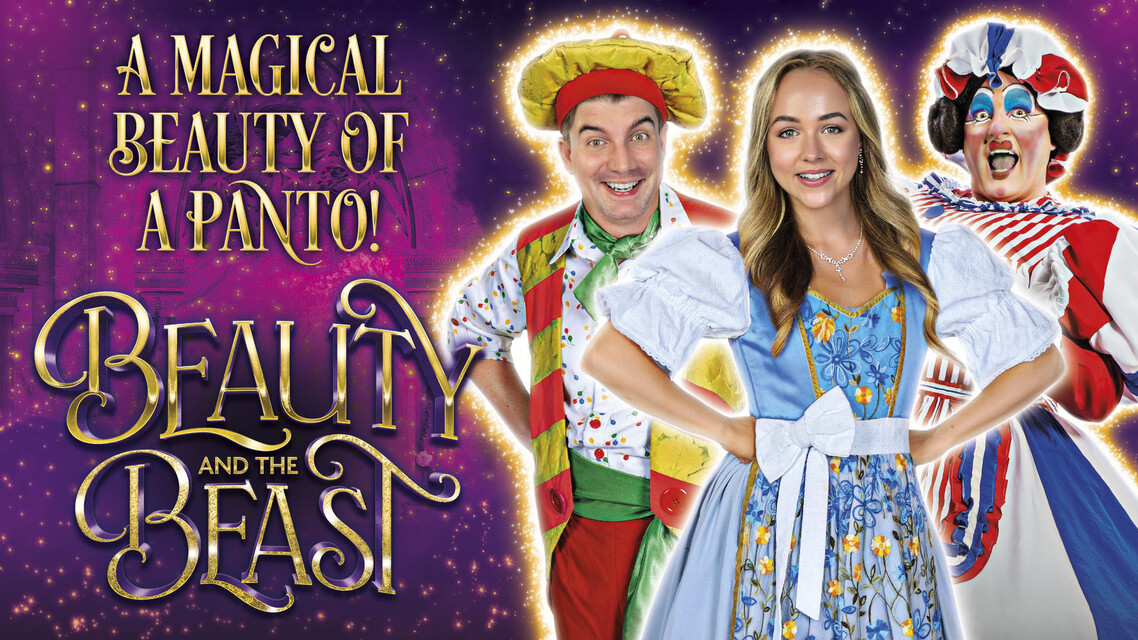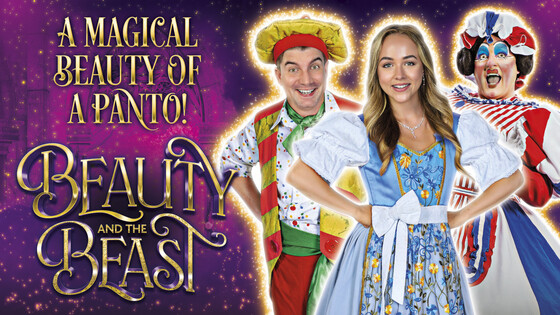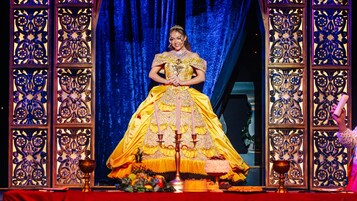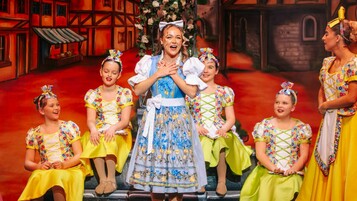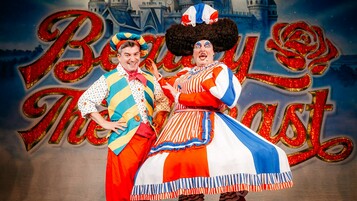News Story
Let’s be honest – no pantomime is complete without its beloved dame. A character so central to panto, she’s more than just comic relief; she’s the heart, soul, and sparkle of the show. With her over-the-top costumes, cheeky one-liners, and knack for breaking the fourth wall, the dame doesn’t just perform – she commands the stage.
With panto favourite Jamie Steen set to steal the spotlight as Polly La Plonk, there’s no better time to dive into the delightful world of these outrageous, hilarious, and iconic characters.
Think you know everything about the pantomime dame? Oh no, you don’t!

Where it all began: The origins of the Dame
Long before the stage lights and sequins, the pantomime dame was bubbling away in the same theatrical cauldron that gave us clowns, jesters, and fools. Rooted in centuries-old traditions of comedic performance, these early entertainers were masters of exaggeration, slapstick, and satire - and as British theatre evolved, so did their roles.
By the 18th and 19th centuries, these male comic performers began embracing overtly feminine traits, not to impersonate women realistically, but rather to parody them. Their performances poked fun at societal expectations of gender, decorum, and class, turning femininity into a wonderfully absurd and theatrical art form all of its own.
The dame emerged as the ultimate comic vehicle: outrageous, affectionate, sometimes bawdy, always captivating. And even today, with her campy charm and fearless presence, she has become one of the most iconic and enduring figures in British theatre. Take a bow!
1806: The first ever Dame takes the stage
While the roots of pantomime reach all the way back to the Middle Ages, the pantomime dame as we know and love her didn’t truly take centre stage until 1806. That milestone moment came with a production titled Harlequin and the Mother Goose; or, The Golden Egg, performed at London’s Theatre Royal, Covent Garden.
In this groundbreaking show, the role of Mother Goose was played by a Mr. Simmons - a performer who delivered more than just side-splitting laughs. His portrayal blended elements of fairy-tale villainy with razor-sharp comic timing, creating a character who was both fantastical and utterly magnetic.
The same production also launched the career of another theatrical giant: Joseph Grimaldi. Widely credited with shaping the modern clown, Grimaldi was so captivated by Simmons’ performance that he later embraced the dame role himself, appearing as Queen Ronabellyana. His leap into dameship proved what many now know to be true - the role of the pantomime dame is simply irresistible, both to audiences and to the actors lucky enough to play her.
The legendary Old Mother Riley
Some dames don’t just light up the stage - they become legends - and few shine brighter than Old Mother Riley. Created and performed by Arthur Lucan, this fiery Irish washerwoman wasn’t just a hit with theatre crowds. Often joined by his real-life wife, Kitty McShane, who played Riley’s on-stage daughter, Lucan took the character far beyond the panto circuit. Old Mother Riley conquered radio, starred in a string of successful films, and became a household name across the UK.
At the height of their fame, Lucan and McShane were earning an astonishing £50,000 a week - a staggering sum for the time, and a testament to just how beloved this larger-than-life dame had become.
The Ugly Sisters get a makeover
Cinderella’s infamous stepsisters are the ultimate panto dames: catty, colourful, and always in style. Originally named Clorinda and Thisbe, these long-standing divas have evolved with the times.
From Sharon and Tracey to Alexis and Krystle, their names often nod to pop culture, keeping them hilariously current. And whether they’re parodying celebrities, influencers, or reality TV stars, these sisters are always dressed to impress... and to insult. Over the years, stars like Alan Haynes, Danny La Rue, Barry Howard, and John Inman have donned the wigs and heels to bring them to life with flair.
Ever wondered where Aladdin’s Widow Twankey got her name? The answer: tea!
The name Twankey might sound odd to modern ears, but it actually has a rather humble and humorous origin. In the mid-19th century, Twankey was the name of a low-cost Chinese green tea that was widely considered inferior, a bit rough around the edges, and certainly not the drink of choice for any self-respecting tea connoisseur. So, when it came time to name the laundress mother in Aladdin, christening her Widow Twankey was a cheeky, knowing wink to her downmarket, no-nonsense character.
And what a character she turned out to be. Over the years, Widow Twankey has become one of the most beloved and recognisable pantomime dames of all time - a whirlwind of mismatched clothes, flour-dusted aprons, and exaggerated facial expressions. She’s the heart of the home, the queen of the laundry, and the undisputed mistress of double entendres.
The role has attracted some of the biggest names in pantomime history, with legendary performers like Dan Leno, Les Dawson, and Danny La Rue all proudly stepping into her sensible shoes, with each performer bringing their own touch of sparkle to the role.
Dames, drag and LGBTQ+ culture
While pantomime is widely celebrated as a form of wholesome, family-friendly entertainment, the role of the dame carries a much deeper and more subversive legacy. Beneath the laughs, slapstick, and glitter lies a rich history of gender play, parody, and performance that connects directly to the world of drag.
Long before RuPaul sashayed onto television screens or drag queens became mainstream pop culture icons, pantomime dames were challenging gender norms on stages across Britain. These flamboyant, larger-than-life characters - always played by men - delighted in blurring the lines between masculine and feminine, using exaggerated costumes, makeup, and mannerisms to mock and celebrate womanhood in equal measure.
In an era when LGBTQ+ identities were marginalised or hidden, pantomime offered a rare and socially acceptable outlet for gender non-conformity and queer expression. Wrapped in the safe packaging of tradition and humour, the dame allowed performers to explore ideas of identity, sexuality, and self-presentation in a way that was both public and protected.
For many LGBTQ+ performers, the pantomime stage has been a powerful and playful space for self-expression and celebration, and long may it continue!
Curtain Call... Eventually
Today’s pantomimes are typically brisk, high-energy affairs, wrapping up neatly in just enough time for some slapstick chaos, a sing-along, a few groan-worthy puns, and a happy-ever-after. But back in the 18th and 19th centuries, pantomime was an entirely different beast: longer, grander, and far more ambitious in scale.
These early pantos were sprawling theatrical marathons, often running for three, four, even five hours at a stretch. One particularly legendary production, Sleeping Beauty and the Beast, staged in 1900, is rumoured to have lasted well over five hours. The show featured multiple interwoven storylines, an enormous ensemble cast, and elaborate spectacle - enough to make even today’s West End blockbusters seem modest.
Of course, tastes have changed. Today’s audiences prefer their pantos a little shorter and snappier, especially when younger children are involved. But that spirit of lavish, no-holds-barred entertainment? That remains. Modern pantomimes may be leaner in length, but they continue to honour their marathon predecessors with the same joyful chaos, variety, and sense of theatrical wonder.
The countdown is officially on - have you got your tickets to Beauty and the Beast yet? Starring West End wonder and soap star Ellie Dadd alongside Charlie Guest and, of course, our fabulous Dame, Jamie Steen.
